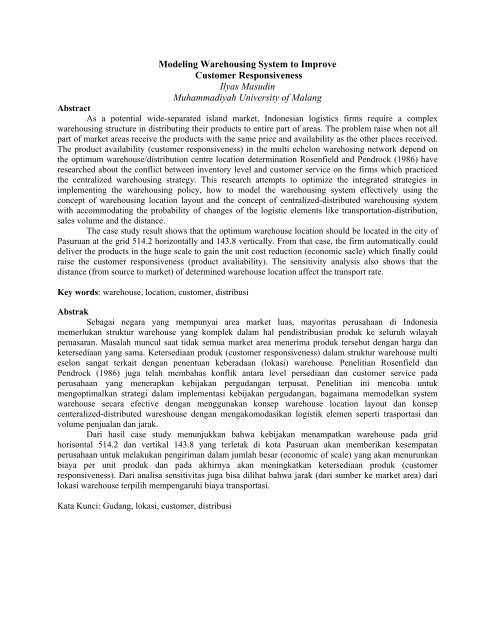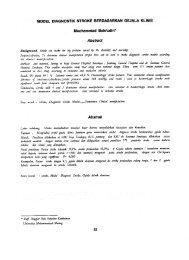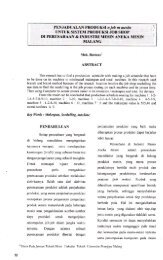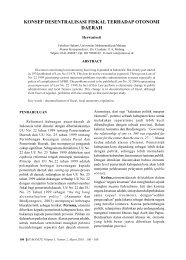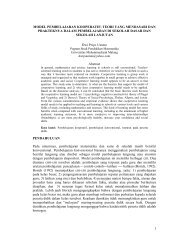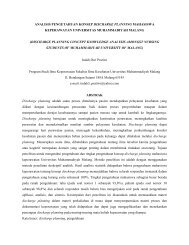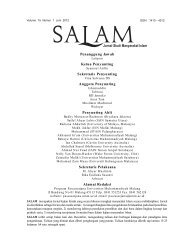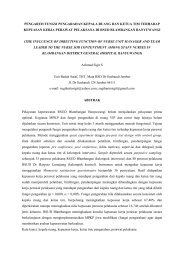Modeling Warehousing System to Improve Customer ...
Modeling Warehousing System to Improve Customer ...
Modeling Warehousing System to Improve Customer ...
Create successful ePaper yourself
Turn your PDF publications into a flip-book with our unique Google optimized e-Paper software.
<strong>Modeling</strong> <strong>Warehousing</strong> <strong>System</strong> <strong>to</strong> <strong>Improve</strong><br />
Cus<strong>to</strong>mer Responsiveness<br />
Ilyas Masudin<br />
Muhammadiyah University of Malang<br />
Abstract<br />
As a potential wide-separated island market, Indonesian logistics firms require a complex<br />
warehousing structure in distributing their products <strong>to</strong> entire part of areas. The problem raise when not all<br />
part of market areas receive the products with the same price and availability as the other places received.<br />
The product availability (cus<strong>to</strong>mer responsiveness) in the multi echelon warehosing network depend on<br />
the optimum warehouse/distribution centre location determination Rosenfield and Pendrock (1986) have<br />
researched about the conflict between inven<strong>to</strong>ry level and cus<strong>to</strong>mer service on the firms which practiced<br />
the centralized warehousing strategy. This research attempts <strong>to</strong> optimize the integrated strategies in<br />
implementing the warehousing policy, how <strong>to</strong> model the warehousing system effectively using the<br />
concept of warehousing location layout and the concept of centralized-distributed warehousing system<br />
with accommodating the probability of changes of the logistic elements like transportation-distribution,<br />
sales volume and the distance.<br />
The case study result shows that the optimum warehouse location should be located in the city of<br />
Pasuruan at the grid 514.2 horizontally and 143.8 vertically. From that case, the firm au<strong>to</strong>matically could<br />
deliver the products in the huge scale <strong>to</strong> gain the unit cost reduction (economic sacle) which finally could<br />
raise the cus<strong>to</strong>mer responsiveness (product avaliability). The sensitivity analysis also shows that the<br />
distance (from source <strong>to</strong> market) of determined warehouse location affect the transport rate.<br />
Key words: warehouse, location, cus<strong>to</strong>mer, distribusi<br />
Abstrak<br />
Sebagai negara yang mempunyai area market luas, mayoritas perusahaan di Indonesia<br />
memerlukan struktur warehouse yang komplek dalam hal pendistribusian produk ke seluruh wilayah<br />
pemasaran. Masalah muncul saat tidak semua market area menerima produk tersebut dengan harga dan<br />
ketersediaan yang sama. Ketersediaan produk (cus<strong>to</strong>mer responsiveness) dalam struktur warehouse multi<br />
eselon sangat terkait dengan penentuan keberadaan (lokasi) warehouse. Penelitian Rosenfield dan<br />
Pendrock (1986) juga telah membahas konflik antara level persediaan dan cus<strong>to</strong>mer service pada<br />
perusahaan yang menerapkan kebijakan pergudangan terpusat. Penelitian ini mencoba untuk<br />
mengoptimalkan strategi dalam implementasi kebijakan pergudangan, bagaimana memodelkan system<br />
warehouse secara efective dengan menggunakan konsep warehouse location layout dan konsep<br />
centeralized-distributed wareshouse dengan mengakomodasikan logistik elemen seperti trasportasi dan<br />
volume penjualan dan jarak.<br />
Dari hasil case study menunjukkan bahwa kebijakan menampatkan warehouse pada grid<br />
horisontal 514.2 dan vertikal 143.8 yang terletak di kota Pasuruan akan memberikan kesempatan<br />
perusahaan untuk melakukan pengiriman dalam jumlah besar (economic of scale) yang akan menurunkan<br />
biaya per unit produk dan pada akhirnya akan meningkatkan ketersediaan produk (cus<strong>to</strong>mer<br />
responsiveness). Dari analisa sensitivitas juga bisa dilihat bahwa jarak (dari sumber ke market area) dari<br />
lokasi warehouse terpilih mempengaruhi biaya transportasi.<br />
Kata Kunci: Gudang, lokasi, cus<strong>to</strong>mer, distribusi
I. Introduction<br />
In the global business, warehousing is one<br />
of the main key in the flow of supply chain<br />
management which cost a lot of money in<br />
providing the warehouse itself, inven<strong>to</strong>ry (work in<br />
process or finished goods) and other facilities.<br />
However, warehousing strategy could be the<br />
effective way <strong>to</strong> reach and service the cus<strong>to</strong>mers,<br />
even a company can save millions of dollar in<br />
logistic costs and improve the level of service<br />
simultaneously by managing the effective number,<br />
size and location of warehouses <strong>to</strong> replenish the<br />
retails or cus<strong>to</strong>mers demand (Theo and Shu, 2004,<br />
396). There are two options of warehousing<br />
strategy in term of the degree of controlling the<br />
inven<strong>to</strong>ry level and cus<strong>to</strong>mer service levels; those<br />
are centralization and decentralization (Rosenfield<br />
and Pendrock, 1986, 23). The two types of those<br />
warehousing strategy give very different results in<br />
the business of inven<strong>to</strong>ry level and the ability in<br />
covering cus<strong>to</strong>mer’s demand.<br />
Most of the inven<strong>to</strong>ry system used by<br />
industries in Indonesia have problem in the<br />
business of providing their products <strong>to</strong> the entire<br />
market areas especially in the distributed market<br />
location with the same level of availability. The<br />
distance is <strong>to</strong>o far between the production sources<br />
and warehouses, will force the companies <strong>to</strong> s<strong>to</strong>ck<br />
their products in a huge numbers in particular<br />
warehouses/distribution centers that will increase<br />
the logistics cost especially on the inven<strong>to</strong>ry costs.<br />
Au<strong>to</strong>matically, the selling price will rise as well.<br />
On the other hand, some warehouses have a very<br />
low inven<strong>to</strong>ry that means the product availability<br />
is low and will impact on the high backorder, lost<br />
sale and lost cus<strong>to</strong>mers.<br />
From the problems above, the reserah will be<br />
designed in<strong>to</strong> three stages. In detail will be<br />
described by the following explanation:<br />
Research stage I:<br />
- Determining the warehouse location optimally<br />
by considering the aspects such as:<br />
• Geographical Condistion<br />
• Market Areas<br />
• Source/production plant<br />
Research stage II:<br />
- Some significant influences of the logistics’<br />
elements changes <strong>to</strong> the <strong>to</strong>tal logistics cost<br />
from the designed warehouse location model.<br />
In this stage will be followed by sensitivity<br />
analyzing of changes of:<br />
• The distribution-transportation cost<br />
• The distance and The sales volume / demand<br />
Research stage III:<br />
- Determining the pull-push system on the designed<br />
warehouse models with the parameters:<br />
• Inven<strong>to</strong>ry level<br />
• Cu<strong>to</strong>mer service level<br />
• Back order and lost sale<br />
II. Literature Review<br />
2.1 The Role of Warehouse<br />
A warehouse is originally a place <strong>to</strong> s<strong>to</strong>re<br />
inven<strong>to</strong>ry, but in current logistic system development,<br />
the role of warehousing has been changed in term of<br />
leveling the productivity and the flowing of raw<br />
material, parts and finished goods as well as the<br />
consolidation terminals such as break bulk and crossdock<br />
facilities (Bowersox and Closs, 1986, 394).<br />
A key success fac<strong>to</strong>r in some big wholesalers<br />
and retailers of their warehousing activities is how <strong>to</strong><br />
meet the cus<strong>to</strong>mers’ expectation and warehouse<br />
management including the cost involved. The most<br />
appropriate example success in managing efficiently<br />
the warehouses is Sara Lee, North Carolina. This<br />
company re-lays out and au<strong>to</strong>mates the warehouse,<br />
reducing the lead time from warehouse <strong>to</strong> cus<strong>to</strong>mers<br />
(cus<strong>to</strong>mer service) and lower the cost associated<br />
(Coyle, Bardi and Langley, 1992, 14). They stated<br />
that the warehouses also give several value-adding<br />
roles in logistic system such as transportation<br />
consolidation, product mixing, service and safety<br />
s<strong>to</strong>ck. It means that the add value of warehousing<br />
system is more beneficial than cost <strong>to</strong> a product. Some<br />
big wholesalers or retailers warehousing will avoid<br />
the interruption of product, semi finished product or<br />
raw materials flow from company <strong>to</strong> cus<strong>to</strong>mers or<br />
from suppliers <strong>to</strong> plants. However, some of them<br />
consider about just in time (JIT) or zero inven<strong>to</strong>ry<br />
(non s<strong>to</strong>cks) concept that minimize the number of<br />
warehouse where they will s<strong>to</strong>re items only if they are<br />
required. This is important because the number of<br />
warehouses will impact directly <strong>to</strong> the cost involved<br />
in warehousing such as transportation cost, inven<strong>to</strong>ry<br />
cost, cost of lost sale (service level) and warehouse<br />
cost, therefore the best way <strong>to</strong> decide the number of<br />
warehouses is by trade-cost evaluation. According <strong>to</strong><br />
Coyle, Bardi and Langley (1992, 375) if the number<br />
of warehouses increase the inven<strong>to</strong>ry cost will<br />
increase <strong>to</strong>o whereas the lost sale cost decrease. The
figure below shows how the number of<br />
warehouses impacts the other costs:<br />
The figure describes that the number of<br />
warehouses will affects four basic warehousing<br />
costs such as inven<strong>to</strong>ry cost, warehousing cost,<br />
transportation cost and the lost sale cost (service<br />
cost). In this research we will concentrate the two<br />
of them: inven<strong>to</strong>ry cost and service level. As<br />
shown on the figure above, the more number of<br />
warehouses, the more inven<strong>to</strong>ries and the<br />
warehouse numbers will decrease the cost of lost<br />
sale or in the other words the cus<strong>to</strong>mer service<br />
level will increase. The <strong>to</strong>tal logistic cost also<br />
depend on the transportation cost which<br />
individually affected by how many number of<br />
warehouse should be served, the more number of<br />
warehouses served the more expensive<br />
transportation cost.<br />
2.2 Centralized Warehouse versus the<br />
Inven<strong>to</strong>ry in 2 echelon system<br />
The basic function of warehouse is s<strong>to</strong>rage<br />
or holding goods inven<strong>to</strong>ry for periods of time.<br />
Coyle, Bardi and Langley (1992, 354) said that the<br />
most fundamental problem in warehousing system<br />
is the high cost of holding finished goods for long<br />
time periods. It is not just hold the finished goods<br />
(the high value products) but also the movement of<br />
product or inven<strong>to</strong>ry turnover such as<br />
consolidation break bulk or cross docking. All<br />
these activities are basically costly and risky in<br />
term of damage, loss and obsolesces besides the<br />
opportunity cost when the capital of inven<strong>to</strong>ry<br />
invested <strong>to</strong> other more beneficial areas.<br />
One of the most important tasks of<br />
managing warehouse is how <strong>to</strong> decide <strong>to</strong> provide<br />
warehouses in the system. The centralized<br />
warehouse in the echelon system could be the<br />
choice <strong>to</strong> control the inven<strong>to</strong>ry. Inven<strong>to</strong>ry carrying<br />
cost become substantial effect in this strategy, like<br />
Rosenfield and Pendrock (1986, 21) example on<br />
the self distribution network, the inven<strong>to</strong>ry carrying<br />
cost could be 2.5% of sales, a significant proportion.<br />
In the centralization strategy, inven<strong>to</strong>ry can be<br />
centralized at production facility or central warehouse<br />
where the central warehouse could be a consolidation<br />
of purchasing point or even as a part of production<br />
facility. The centralized warehousing process in 2<br />
echelon systems is explained briefly from the figure<br />
below:<br />
On the centralized warehouse which used push<br />
system, the inven<strong>to</strong>ries included the safety s<strong>to</strong>cks are<br />
located in the central warehouse and cover the entire<br />
system <strong>to</strong> anticipate the variation of production lead<br />
time. This is the main point why the centralized carry<br />
much money in inven<strong>to</strong>ry cost. The inven<strong>to</strong>ry level<br />
will increase in this push centralized warehouse<br />
system when the number of remote warehouses<br />
increases. The other inven<strong>to</strong>ry occurs in warehouse<br />
when replenish its inven<strong>to</strong>ry from external source<br />
such as supplier or other production plants and there<br />
is also a holding cost counted per unit time inven<strong>to</strong>ry<br />
in remote warehouses or retailers (Teo and Shu, 2004,<br />
397). Teo and Shu also said that in overall, the profit<br />
of firms which used the centralized warehouses may<br />
lower than decentralization since the grass root<br />
(cus<strong>to</strong>mer level) or local conditions are uncertain such<br />
as the uncertain cus<strong>to</strong>mer’s quantity demand,<br />
uncertain lead time of supplier replenishment, local<br />
tax regulation, or local transportation’s cost<br />
fluctuation.<br />
In the other hand, decentralized warehouse<br />
system which focuses on the pull of inven<strong>to</strong>ry control<br />
implies that remote warehouses make orders <strong>to</strong> the<br />
central warehouse. The quantity demand from<br />
cus<strong>to</strong>mers becomes the quantity <strong>to</strong> make order <strong>to</strong> the<br />
central warehouse. The problem rise in term of the<br />
replenishment of orders from the central warehouse <strong>to</strong><br />
remote warehouses when it can not be done on the<br />
time because the individual remote warehouse<br />
demands are not controlled centrally (Rosenfield and<br />
Pendrock, 1986, 22) which cause the high variation of
eplenishment from central warehouse <strong>to</strong> remote<br />
warehouses, therefore the procurement quantities<br />
in this system are based on the separate order<br />
quantities of the different system s<strong>to</strong>cking of<br />
remote warehouse location or there will be a<br />
flexibility in replenishing the order <strong>to</strong> remote<br />
warehouses (retailers). This will sometimes affect<br />
the <strong>to</strong>tal inven<strong>to</strong>ry in both the remote warehouses<br />
and central warehouse where there will be a high<br />
risk for central warehouse <strong>to</strong> s<strong>to</strong>ck out and there<br />
will probably a longer lead time for the remote<br />
warehouses or retailers <strong>to</strong> receive their orders due<br />
<strong>to</strong> the central warehouse must cover all the remote<br />
warehouse order with different replenishment time.<br />
2.3 Warehouse and Inven<strong>to</strong>ry in 2 echelon<br />
One of the most important tasks of managing<br />
warehouse in a two echelon system is how <strong>to</strong><br />
decide <strong>to</strong> provide inven<strong>to</strong>ry in the system.<br />
Inven<strong>to</strong>ry carrying cost become substantial effect<br />
in the warehousing strategy implemented.<br />
Rosenfield and Pendrock (1986, 21) example on<br />
the self distribution network that the inven<strong>to</strong>ry<br />
carrying cost from the plant <strong>to</strong> the lower level of<br />
warehouses could be 2.5 percent of sales, a<br />
significant proportion. Two echelon warehousing<br />
system inven<strong>to</strong>ry flow from production facility or<br />
central warehouse where the central warehouse<br />
could be a consolidation of purchasing point or<br />
even as a part of production facility. The figure of<br />
how two echelon warehousing system flow the<br />
inven<strong>to</strong>ry is explained briefly from the figure 2.<br />
The inven<strong>to</strong>ries included the safety s<strong>to</strong>cks are<br />
located in each warehouse level <strong>to</strong> anticipate the<br />
variation of production lead time. The inven<strong>to</strong>ry<br />
occurs in warehouse when replenish its inven<strong>to</strong>ry<br />
from external source such as supplier or other<br />
production plants and there is also a holding cost<br />
counted per unit time inven<strong>to</strong>ry in remote<br />
warehouses or retailers (Teo and Shu, 2004, 397).<br />
2.4 Number of Warehouse<br />
In the centralized warehouse problem, the<br />
number of warehouse has a significant influence in<br />
the <strong>to</strong>tal inven<strong>to</strong>ry in all warehouses. If the number<br />
of warehouse increases, the local safety s<strong>to</strong>ck in<br />
each warehouse will decrease because the safety<br />
s<strong>to</strong>ck is distributed <strong>to</strong> more location. According <strong>to</strong><br />
Rosenfield and Pendrock (1986, 26), in this<br />
warehousing system, inven<strong>to</strong>ries in any<br />
warehouses consists of cycle s<strong>to</strong>cks and safety<br />
s<strong>to</strong>cks where the <strong>to</strong>tal cycle s<strong>to</strong>cks in whole system<br />
will not change when the number of warehouse<br />
increases because of the quantity of cycle s<strong>to</strong>cks in<br />
that specific warehouse is usually averaging in half a<br />
cycle time supply. That ensure the demand can be<br />
covered securely because of there is an extra s<strong>to</strong>ck<br />
when the supply received late (constant demand is<br />
assumed rarely occurred in the real world). The<br />
obvious result of this is probably the optimized<br />
cus<strong>to</strong>mer services by reducing the lost sales when<br />
there are a very high variations in cus<strong>to</strong>mer’s<br />
demands but there is still an extra inven<strong>to</strong>ry can be<br />
released <strong>to</strong> cover the unpredictable cus<strong>to</strong>mer’s<br />
demand.<br />
On the other hand, the increase number of<br />
warehouses in the pull system means that there are<br />
more cus<strong>to</strong>mers’ demand variations which affect the<br />
accuracy of order replenishment from central<br />
warehouse <strong>to</strong> retailers or remote warehouses. This<br />
probably impacts the level of s<strong>to</strong>cks in each retailer or<br />
remote warehouse in term of product availability. It is<br />
explained clearly by Coyle, Bardi and Langley (The<br />
Management of Business Logistic, 1992, pg. 60) in the<br />
figure (the trade-off between the number of<br />
warehouses and the cost of lost sale) that the more<br />
number of warehouses, the less cost of lost sale or we<br />
can say that the cus<strong>to</strong>mer service level will be good,<br />
however the more number of warehouses also reflect<br />
the more demand variations in each remote<br />
warehouses and retailers that means the central<br />
warehouse (plant) in the decentralized warehousing<br />
system will have a huge difficulties in covering all<br />
those warehouses’ fluctuated demand in different<br />
quantity (lot size), different lead time and different<br />
distances, or in other words that the probability of<br />
failure <strong>to</strong> replenish the product’s orders in this system<br />
is higher than the centralized warehousing policy.<br />
2.5 Sales Volume<br />
The decision of choosing the warehouse<br />
strategy whether centralization or decentralization<br />
also depend on the kind items sold if fast-selling items<br />
or slow-selling items. When the items sold are fast<br />
selling, the warehousing strategy which s<strong>to</strong>cks plenty<br />
of inven<strong>to</strong>ries such as centralized system; there is no<br />
influence in term of increasing the safety s<strong>to</strong>ck<br />
especially in the remote warehouses (Rosenfield and<br />
Pendrock, 1986, 28). This is happened because of the<br />
large s<strong>to</strong>cks which enter in<strong>to</strong> warehouses are balanced<br />
by the fast selling s<strong>to</strong>cks sold or we can say that the<br />
high turnover of in and out s<strong>to</strong>cks will not impact
significantly in the increase of the inven<strong>to</strong>ry s<strong>to</strong>cks<br />
in this warehousing system. On the other hand, the<br />
slow-selling items are more suitable for the<br />
decentralization system in the business of products<br />
availability. The independent remote warehouse<br />
which its s<strong>to</strong>cks are not supplied regularly cause<br />
the lack of inven<strong>to</strong>ry when serving the fast selling<br />
items, the obvious impacts of this are increasing<br />
the back order activity and even worse, lost sale.<br />
The high back order and lost sale level will<br />
au<strong>to</strong>matically increase the <strong>to</strong>tal cost of logistic.<br />
2.6 Transshipment Cost<br />
The other fac<strong>to</strong>r influence the decision in<br />
warehousing is about the transshipment and<br />
transportation issue because transportation or<br />
transshipment from plant or central warehouse <strong>to</strong><br />
remote warehouses related <strong>to</strong> the delivery time and<br />
the replenishment (Hidaka and Okano, 1997,<br />
1215). In the centralized warehousing system, the<br />
transshipment will be done periodically based on<br />
the central warehouse/plant decision, while in the<br />
decentralized warehousing system, the order<br />
transshipment will be done based on the remote<br />
warehouses or retailers demand condition<br />
(independent) so that there will be probably<br />
imbalanced inven<strong>to</strong>ries among the remote<br />
warehouses/retailers which definitely affect the<br />
transportation/transshipment cost in term of<br />
strategy <strong>to</strong> cover the delivery of whole remote<br />
warehouses/retailers. In conclusion, the<br />
decentralized warehousing system will require<br />
more expensive in transshipment or transportation<br />
cost because of imbalance inven<strong>to</strong>ries or we can<br />
say that the higher cost of transportation (the<br />
longer distance of transshipment), the centralized<br />
warehousing system is more favorable.<br />
2.7 <strong>Warehousing</strong> and Cus<strong>to</strong>mer Service<br />
Cus<strong>to</strong>mer service is the main key in warehousing<br />
activities in term of adding value <strong>to</strong> products<br />
which s<strong>to</strong>red in s<strong>to</strong>rage and it should be<br />
continuously measured and moni<strong>to</strong>red within the<br />
warehouse (Daly, 1993, 62). The review of<br />
cus<strong>to</strong>mer service improvement can be evaluated<br />
trough the warehouse activities such as cus<strong>to</strong>mer<br />
order fulfillment, pick and s<strong>to</strong>re the right materials<br />
and pack and ship <strong>to</strong> right address. Daly (1993, 61)<br />
found that the level of cus<strong>to</strong>mer service can be<br />
measured by using some measurements based on<br />
the cus<strong>to</strong>mers requirements and fac<strong>to</strong>r impacted.<br />
The following table figures out how warehouse can<br />
impact cus<strong>to</strong>mer service and what measurement used<br />
<strong>to</strong> measure:<br />
Source: Daly, 1993.<br />
III. The Research Me<strong>to</strong>dology<br />
This research will be designed in<strong>to</strong> three stages <strong>to</strong><br />
overcome the problems <strong>to</strong> determine the final model<br />
of the distribution system by determining the<br />
optimum warehouse location and <strong>to</strong> explore the<br />
impacts of the changes of the transportation rates,<br />
capacity and the distance of warehouse location and<br />
finally by analyzing how the push-pull inven<strong>to</strong>ry<br />
policy in the multi echelon could be implemented in<br />
the designed distribution network model particularly<br />
its effect <strong>to</strong> the inven<strong>to</strong>ry level and cus<strong>to</strong>mer<br />
responsiveness. Research will be conducted in some<br />
industries at eastern Java especially in industries<br />
which have well developed multi echelon distribution<br />
network structure.<br />
The qualitative data such as the current warehouse<br />
structure, distribution network, the number and<br />
location of warehouses and the company’s market<br />
areas will be gathered <strong>to</strong>gether with the quantitative<br />
data as logistics’ costs (transportation and inven<strong>to</strong>ry<br />
cost) and demand fulfillment rate. The research is a<br />
case study research (inductive research) which uses<br />
case study as the main data <strong>to</strong> form the<br />
opinion/general conclusion (Eisenhardt, 1989) about<br />
how <strong>to</strong> model warehousing strategy of multi echelon<br />
company and its impacts <strong>to</strong> the designed model from<br />
logistic aspects and impact of inven<strong>to</strong>ry policy (pushpull<br />
system) <strong>to</strong> the level of inven<strong>to</strong>ry, the availability<br />
level and cus<strong>to</strong>mer service level. Thus, in the<br />
inductive research will require empiric data from the<br />
single/multi sources.The parameters will be used in<br />
this research as the pivot data in the first and second<br />
research stage are the cover-age ability of the market<br />
area and <strong>to</strong>tal logistic cost that will be measured by<br />
the changes of other logictics’ elements such as<br />
transportation-transhipment cost, capacity-demand<br />
and the distance between sources-market areas. Some
metrics will be used <strong>to</strong> measure the impact in the<br />
third research stage (push-pull system or<br />
centralized-distributed system) are the inven<strong>to</strong>ry<br />
level in which correlate <strong>to</strong> inven<strong>to</strong>ry carrying<br />
costs, safety s<strong>to</strong>ck and on hand inven<strong>to</strong>ry and other<br />
parameters like cus<strong>to</strong>mers service level that<br />
correlated <strong>to</strong> the cus<strong>to</strong>mer demand responsiveness,<br />
back order level and lost sale. The proposed<br />
problem solving <strong>to</strong> solve the logistic problem is<br />
divided in<strong>to</strong> some research steps:<br />
Stage I<br />
• Step 1: Current logistics strategy observation<br />
In this step, the field observation will be held<br />
by observing the company’s distribution<br />
activity network especially company’s strategy<br />
in distribution process, distribu<strong>to</strong>r location and<br />
covered market area.<br />
• Step 2: Determining the problems<br />
From the information gathered in the previous<br />
step, the next step is determining the problem<br />
faced b the firms. In this step, will be focused<br />
on the determining the outbound logistic.<br />
Brain s<strong>to</strong>rming with some expertise in logistics<br />
such as the logistics manager and CEO will be<br />
conducted <strong>to</strong> formulate problems.<br />
• Step 3: Identifying alternatives<br />
After formulating the problems, the next step<br />
is identifying some alternatives in solving<br />
problems. The proposed alternatives related <strong>to</strong><br />
company’s distribution strategy (location and<br />
the number of distribution centres). The<br />
technique will be used in this step is grid<br />
technique. Moreover, <strong>to</strong> support the problem<br />
solving process, software and hardware will be<br />
prepared for pilot run. The output of this stage<br />
is a design of warehouse layout.<br />
Stage II<br />
• Step 4 - 5: Evaluation and sensitivity analysis.<br />
From pilot run and the output of stage I will be<br />
evaluated (sensitivity analysis) by analyzing<br />
the impact of changes of some logistics<br />
elements such as transportation-distribution<br />
cost, capacity and distances. The output of the<br />
stage II is an impact <strong>to</strong> designed warehouse<br />
location when the variables above changes.<br />
Stage III<br />
• Step 6-7: Inven<strong>to</strong>ry policy Analysis and final<br />
design model of warehousing.<br />
From the output stage II, there will be an<br />
analysis of inven<strong>to</strong>ry policy which can be<br />
implemented <strong>to</strong> manage the inven<strong>to</strong>ry level with<br />
push and pull technique (centralization and<br />
distribution strategy). Once the inven<strong>to</strong>ry policy is<br />
found, the next step is making the final model of<br />
distribution/warehousing.<br />
• Step 8: Conclusion and Recommendation<br />
In this step of stage III, the result of this research<br />
will be focused on the generalising the logistics<br />
concept especially on the warehousing strategy<br />
and distribution on general. Because of this<br />
research is inductive rsearch so the bot<strong>to</strong>m-up<br />
process will be held carefully in this step.<br />
IV. Research Result<br />
The coverage of the market area is around East Jave<br />
that concentrated on the several cities within this<br />
Eatern Java province. The method used <strong>to</strong> determine<br />
the optimum warehouse location in this research<br />
would use the map as the main source <strong>to</strong> develop the<br />
distribution channel aroud the market areas. By using<br />
grid centre technique, the distribution centre will be<br />
located optimally by calculating the chosen cordinates<br />
uses by dividing the <strong>to</strong>tal numera<strong>to</strong>r value of each<br />
vertical and horizontal section by the <strong>to</strong>tal<br />
denomina<strong>to</strong>r value of each vertical and horizontal<br />
section respectively. The following shaped table<br />
informs how the grid centre determined:<br />
Source<br />
/Market<br />
Area<br />
Rate<br />
Rp/pc/k<br />
m (A)<br />
Load<br />
(B)<br />
Grid<br />
Coordinat<br />
Hor Vert<br />
Calculation<br />
AxBxHor AxBxVer<br />
(000) (000)<br />
Malang (S)<br />
Market:<br />
1,000 900 400 100 360,000 90,000<br />
Surabaya (M) 1200 125 420 260 63,000 39,000<br />
Blitar (M) 1000 100 270 70 27,000 7,000<br />
Situbondo (M) 2000 525 800 160 840,000 168,000,<br />
Bojonegoro (M) 2000 150 195 185 58,500 55,500<br />
Total 1,348,50<br />
0<br />
359,500<br />
Hor Vert<br />
Numera<strong>to</strong>r – Sources: SUM<br />
(rate*load*Cordinate)<br />
360,000 90,000<br />
Numera<strong>to</strong>r – Markets: SUM (rate*load*<br />
Cordinate)<br />
925,500 269,500<br />
Total 1,285,50<br />
0<br />
359,500<br />
Denomina<strong>to</strong>r – Sources: SUM (rate*load) 900 900<br />
Denomina<strong>to</strong>r – Markets: SUM (rate*load) 1,600 1,600<br />
Total 2,500 2,500<br />
Grid Centre: Total Numera<strong>to</strong>r / Total<br />
Denomina<strong>to</strong>r<br />
514.2 143.8
The final calculation shown the loca<strong>to</strong>n cordinate<br />
is located at the 514.2 horizontally and 143.8<br />
vertically. It means that based on the grid method,<br />
the location should be around the city had that<br />
such cordinate above (around the city of<br />
Pasuruan).<br />
V. Discussion<br />
5.1 Review of the Result<br />
The firm’s distribution distribution problem was<br />
the unefective product distribution which<br />
distributed directly by salesman <strong>to</strong> the cus<strong>to</strong>mers<br />
or retailers. To solve the problem by determining<br />
the warehouse location optimally is expected that<br />
the distribution centre have functions <strong>to</strong> s<strong>to</strong>re the<br />
products as s<strong>to</strong>cks. This will help firm <strong>to</strong> produce<br />
their products maximally (economic scale) <strong>to</strong> be<br />
s<strong>to</strong>red at distribution centre and also help <strong>to</strong> cover<br />
the fluctuated demand.<br />
The optimal warehouse location is located around<br />
the City of Pasuruan will lead the company <strong>to</strong><br />
cover the whole market areas such as Situbondo<br />
(see the map). The demand prospect shows that the<br />
most potential market is Situbondo that had the<br />
biggest product demand (525 packs). The<br />
warehouse is also projected <strong>to</strong> help <strong>to</strong> cover the<br />
product demand from Bojonegoro and other new<br />
prospect area at the northern cities.<br />
The warehouse should be functioned <strong>to</strong> s<strong>to</strong>ck point<br />
<strong>to</strong> subject the economic scale when the firm<br />
transports the product <strong>to</strong>. This will au<strong>to</strong>matically<br />
decrease the transportation cost, s<strong>to</strong>ck out cost and<br />
cost of shortage that will lead the decrease of <strong>to</strong>tal<br />
distribution cost.<br />
To step the next stage (distribution policy –<br />
centralized or distributed), the final result of<br />
determining the optimal warehouse location will<br />
be used as input <strong>to</strong> analyse how the policy of<br />
product distribution should be.<br />
5.2 The Implication for the Cus<strong>to</strong>mer Service<br />
By locating the warehouse at the determined<br />
location around Pasuruan will impaact on the<br />
cus<strong>to</strong>mer servce performance in the buseness of<br />
product availability. Based on prior condition, in<br />
some potential market areas such as Surabaya and<br />
Situbondo complained that there were often<br />
s<strong>to</strong>ckout because of supplies problem. This is<br />
definitely caused by the distance between source<br />
(Malang) and the markets.<br />
The other advantages by locating the warehouse at<br />
Pasuruan is concerning with continues plan <strong>to</strong> expand<br />
the product market areas and the new potential<br />
markets are the areas which have a tropic climate such<br />
as Gresik, Lamomgan, Probolinggo, Jember dan the<br />
other eastern areas.<br />
The other implication if locating the warehouse at<br />
Pasuruan is decreasing the cost of transportation<br />
regarding the economic scale of product transport. In<br />
the business of product shipment, the more products<br />
carried the cheaper cost of transportation per unit.<br />
Warehouse could be the solution for the firm <strong>to</strong><br />
deliver the products in a huge scale <strong>to</strong> gain the unit<br />
cost reduction. And again, by reducing the cost of<br />
transportation means the product price per unit is<br />
reduced as well.<br />
5.3 Senstivity Analysis: Locational Effects of<br />
Tapering Rates<br />
The distance (from source and <strong>to</strong> market) of the<br />
determined warehouse location affect the transport<br />
rate. The closer warehouse built from the source the<br />
transport rate will be cheaper. However, the transporr<br />
rate will be more expensive when the warehouse is<br />
located far away <strong>to</strong> the market. In summary, the <strong>to</strong>tal<br />
transport rate will be reached at the <strong>to</strong>p (the most<br />
expensive) in the position where the graph line of<br />
From Source line and To Market line crossed in the<br />
optimal distance of them.The locational effects of<br />
determined location based on the constant transport<br />
rate assumption could be drawn as follow:<br />
Km<br />
from<br />
Source<br />
Transport<br />
Rate from<br />
Source<br />
(Rp)<br />
Km <strong>to</strong><br />
Market<br />
Transport<br />
Rate <strong>to</strong><br />
Market<br />
(RP)<br />
Total<br />
Transport<br />
Rate (Rp)<br />
0 0 250 250,000 250,000<br />
100 150,000 200 225,000 375,000<br />
150 200,000 150 200,000 400,000<br />
200 225,000 100 150,000 375,000<br />
250 250,000 0 0 250,000<br />
The figure below describes the graph of locational<br />
effect based on the constant transport rate.<br />
Transport rate<br />
450000<br />
400000<br />
350000<br />
300000<br />
250000<br />
200000<br />
150000<br />
100000<br />
50000<br />
0<br />
Figure 4 Locational effect with constant rate<br />
1 2 3<br />
Kilometre<br />
4 5
VI. Conclussion<br />
Location is a significant consideration in<br />
the business of expanding the sales volume with<br />
the minimum cost. More optimum location <strong>to</strong>be<br />
located as distribution centre, more minimum cost<br />
of distributed market coverage. From the collected<br />
data of the case study found that the required<br />
dictribution centre should be located at the grid<br />
514.2 horizontally and 143.8 vertically (514.2;<br />
143.8). Based on the Jawa Timur map used in the<br />
research, the cordinate are located at around the<br />
city of Pasuruan. The following figure shows<br />
where the detail dictribution location should be<br />
located for the markets area<br />
500<br />
400<br />
300<br />
200<br />
100<br />
0 100 200 300 400 500 600 700 800 900<br />
The Chosen Location as<br />
Distribution Centre:<br />
Pasuruan<br />
References:<br />
Bowersox, JD and Closs, JD 1996, Logistic<br />
management :the integrated Supply chain<br />
process, McGraw-Hill, USA<br />
Caron, F. and Marchet, G. 1996. The Impact of<br />
Inven<strong>to</strong>ry Centralization/Decentralization on<br />
Safety S<strong>to</strong>ck for 2 Echelon <strong>System</strong>. Journal f<br />
Business Logistic 17 (1). Retrieved March 6,<br />
2007, from ABI/INFORM Trade& Industry.<br />
Chopra, S. and Meindl, P. 2001. Supply Chain<br />
Management: Strategy, Planning, and<br />
Operation. Prentice-Hall. New Jersey.<br />
Coyle, J.J., Bardi, J.E., Novack, A.R. 1996.<br />
Transportation 5 th ed. South-Western College<br />
Publishing. Ohio.<br />
Coyle, J.J., Bardi, J.E., Novack, A.R. 1992. The<br />
Management of Business Logistic 6 th ed. West<br />
Publishing Company. Minneapolis.<br />
Daly, 1993. <strong>Warehousing</strong>: The Strategic Weapon For<br />
Cus<strong>to</strong>mer Service, Industrial Engineering<br />
Journal, Vol. 25, No. 5, pg.61. Retrieved<br />
September 5, 2007, from ABI/INFORM Trade&<br />
Industry.<br />
Eisenhardt, K. M. 1989, 'Building theories from case<br />
study research', Academy of Management Review,<br />
vol. 14, no. 4, pp. 532-550.<br />
Hidaka, K. and Okano, H. 1997. Simulated-Based<br />
Approach <strong>to</strong> the Warehouse Location Problem for<br />
a Large Scale Real Instance. Proceeding of the<br />
1997 Winter Simulation Conference. Retrieved<br />
March 6, 2007, from ABI/INFORM Trade&<br />
Industry.<br />
Ho, P. and Perl, J., 1995. Warehouse Location Under<br />
Service-Sensitive Demand. Journal of Business<br />
Logistic, Vol. 16, No. 1, pg. 133-164. Retrieved<br />
September 5, 2007, from ABI/INFORM Trade&<br />
Industry.<br />
Hunnicutt, L. 2001. Mixups in The Warehouse:<br />
Centralized & Decentralized Multi-Plant Firms.<br />
Economic Inquiry 39 (4). Retrieved August 19,<br />
2007, from ABI/INFORM Trade& Industry.<br />
Rosenfield, B.D., and Pendrock, E.M. 1986. The<br />
Effect of Warehouse Configuration Design on<br />
Inven<strong>to</strong>ry Level and Holding Cost. Sloan<br />
Management Review 21 (4). Retrieved August 19,<br />
2007, from ABI/INFORM Trade& Industry.<br />
Teo, C. and Shu, J. 2004. Warehouse-Retailer<br />
Network Design Problem. Operation Research 52<br />
(3). Retrieved August 19, 2007, from<br />
ABI/INFORM Trade& Industry.


